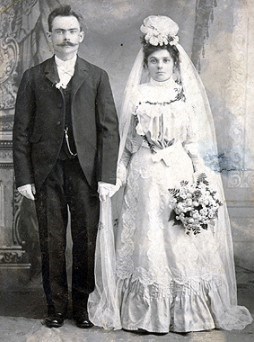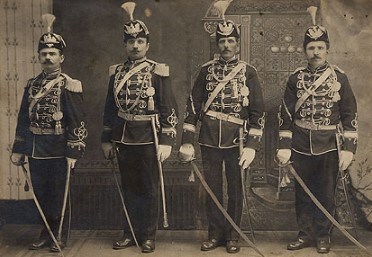Part of a series of articles titled Prominent People in Polish Salem.
Previous: Herman Tyburc
Next: Joseph and Hedwiga Kohn
Article

Courtesy of Linda Moustakis
Teofil Bartnicki first came to the U.S. in 1891 at the age of 16, then returned to his home in the German-occupied area of east-central Poland, where he apparently served in the military. In 1900, he was back in America, this time settling for good in Salem. Pictured on the left, Teofil Bartnicki marries Anastasia Bartnicki, c. 1900.
He was among the most energetic community leaders of the first generation, serving with Wladyslaw Sobocinski and others in the St. Joseph Society to build the St. Joseph Hall and establish a local Polish parish.
Teofil appears to have played many roles in the Society and elsewhere in the community, including carrying money from immigrants back to their families in Poland. On one of these trips, he seems to have become caught up in homeland politics and was detained during the Polish-Bolshevik War of 1920-21.

Courtesy of Linda Moustakis
One of Teofil's projects at the St. Joseph Society was to form a drill team, sometimes known as "Hussars" in Polish organizations. In the image to the right, Teofil Bartnicki stands on the far left with other members of the St. Joseph Society drill team.
Active between 1907 and 1921, the uniforms and precision drill movements recall both the long military lineage of which many Poles were deeply proud and the Austrian and Prussian martial traditions in which many Polish men, including Teofil, had been trained. Like the Chopin Choir and other expressions of Polish "high culture," the drill team made a statement about the glories of Polish history and culture, countering American stereotypes of Poles as merely peasant laborers.
In later life, Teofil seems to have decided to chronicle the history of the St. Joseph Society. One of his granddaughters recalls him spending hours in the basement writing in a big book, seemingly the large leather-bound ledger that is now in the collection of Salem Maritime National Historic Site. The handwritten pages are in a somewhat archaic form of Polish and have only been translated for the first decade of the Society's existence. The remaining records, extending into the 1930s, undoubtedly contain a rich wealth of information about Polish Salem in the early twentieth century.
Part of a series of articles titled Prominent People in Polish Salem.
Previous: Herman Tyburc
Next: Joseph and Hedwiga Kohn
Last updated: January 11, 2022